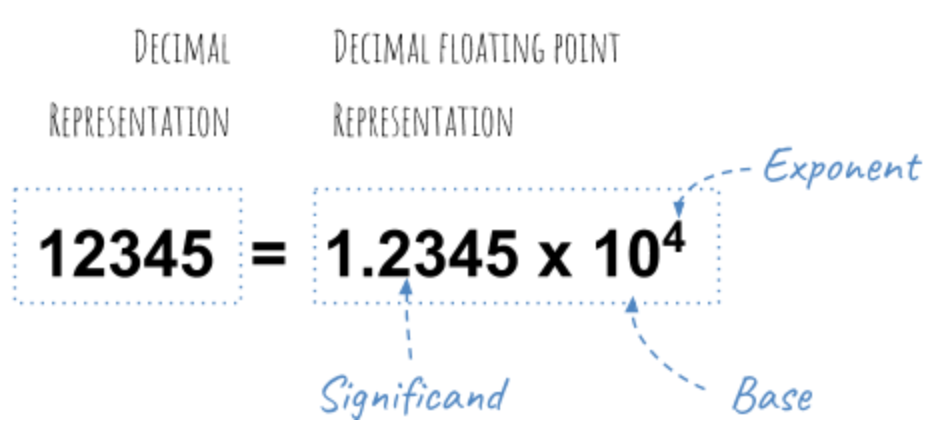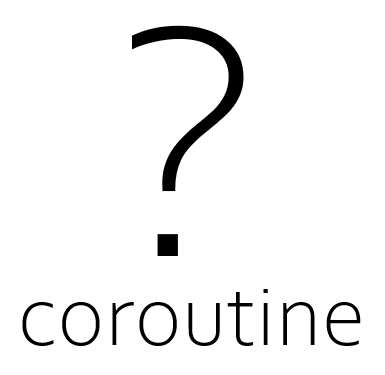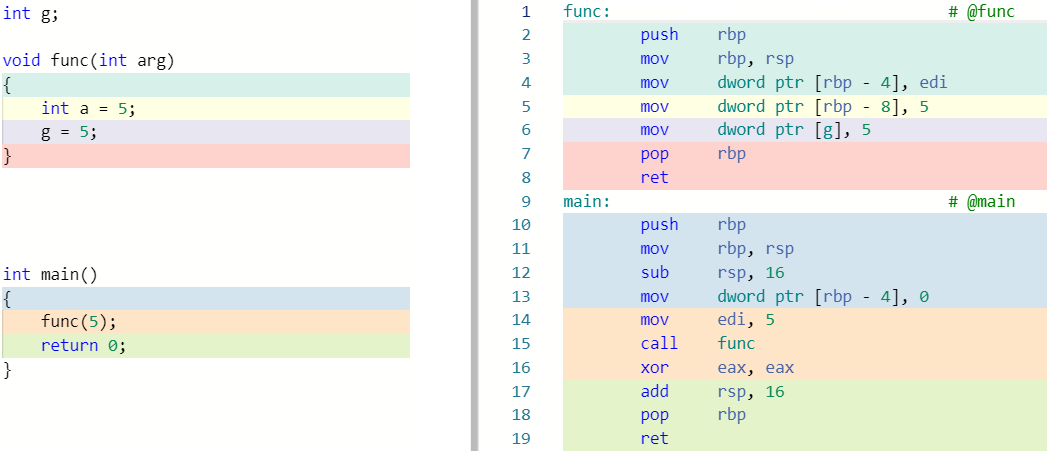This article is just a simplification of the IEEE 754 standard. Here, we will see how floating-point no stored in memory, floating-point exceptions/rounding, etc. But if you will want to find more authoritative sources then go for
- What Every Computer Scientist Should Know About Floating-Point Arithmetic
- https://en.wikipedia.org/wiki/IEEE_754-1985
- https://en.wikipedia.org/wiki/Floating_point.
Floating-point numbers stored by encoding significand & the exponent (along with a sign bit)
- Above line contains 2-3 abstract terms & I think you will unable to understand the above line until you read further.
Contents
Floating Point Number Memory Layout
+-+--------+-----------------------+ | | | | +-+--------+-----------------------+ ^ ^ ^ | | | | | +-- significand(width- 23 bit) | | | +------------------- exponent(width- 8 bit) | +------------------------ sign bit(width- 1 bit)
A typical single-precision 32-bit floating-point memory layout has the following fields :
- sign
- exponent
- significand(AKA mantissa)
Sign
- The high-order bit indicates a sign.
0indicates a positive value,1indicates negative.
Exponent
- The next 8 bits are used for the exponent which can be positive or negative, but instead of reserving another sign bit, they’re encoded such that
1000 0000represents0, so0000 0000represents-128and1111 1111represents127. - How does this encoding work? go to exponent bias or see it in next point practically.
Significand
- The remaining 23-bits used for the significand(AKA mantissa). Each bit represents a negative power of 2 countings from the left, so:
01101 = 0 * 2^-1 + 1 * 2^-2 + 1 * 2^-3 + 0 * 2^-4 + 1 * 2^-5
= 0.25 + 0.125 + 0.03125
= 0.40625
OK! We are done with basics.
Let’s Understand Practically
- So, we consider very famous float value
3.14(PI) example. - Sign: Zero here, as PI is positive!
Exponent calculation
3is easy:0011in binary- The rest,
0.14
0.14 x 2 = 0.28, 0 0.28 x 2 = 0.56, 00 0.56 x 2 = 1.12, 001 0.12 x 2 = 0.24, 0010 0.24 x 2 = 0.48, 00100 0.48 x 2 = 0.96, 001000 0.96 x 2 = 1.92, 0010001 0.92 x 2 = 1.84, 00100011 0.84 x 2 = 1.68, 001000111 And so on . . .
- So,
0.14 = 001000111...If you don’t know how to convert decimal no in binary then refer this float to binary. - Add
3,11.001000111... with exp 0 (3.14 * 2^0) - Now shift it (normalize it) and adjust the exponent accordingly
1.1001000111... with exp +1 (1.57 * 2^1) - Now you only have to add the bias of
127to the exponent1and store it(i.e.128=1000 0000)0 1000 0000 1100 1000 111... - Forget the top
1of the mantissa (which is always supposed to be1, except for some special values, so it is not stored), and you get:0 1000 0000 1001 0001 111... - So our value of
3.14would be represented as something like:
0 10000000 10010001111010111000011
^ ^ ^
| | |
| | +--- significand = 0.7853975
| |
| +------------------- exponent = 1
|
+------------------------- sign = 0 (positive)
- The number of bits in the exponent determines the range (the minimum and maximum values you can represent).
Summing up Significand
- If you add up all the bits in the significand, they don’t total
0.7853975(which should be, according to 7 digit precision). They come out to0.78539747. - There aren’t quite enough bits to store the value exactly. we can only store an approximation.
- The number of bits in the significand determines the precision.
- 23-bits gives us roughly 6 decimal digits of precision. 64-bit floating-point types give roughly 12 to 15 digits of precision.
Strange! But Fact
- Some values cannot represent exactly no matter how many bits you use. Just as values like 1/3 cannot represent in a finite number of decimal digits, values like 1/10 cannot represent in a finite number of bits.
- Since values are approximate, calculations with them are also approximate, and rounding errors accumulate.
Let’s See Things Working
#include <stdio.h>
#include <string.h>
/* Print binary stored in plain 32 bit block */
void intToBinary(unsigned int n)
{
int c, k;
for (c = 31; c >= 0; c--)
{
k = n >> c;
if (k & 1) printf("1");
else printf("0");
}
printf("\n");
}
int main(void)
{
unsigned int m;
float f = 3.14;
/* See hex representation */
printf("f = %a\n", f);
/* Copy memory representation of float to plain 32 bit block */
memcpy(&m, &f, sizeof (m));
intToBinary(m);
return 0;
}
- This C code will print binary representation of float on the console.
f = 0x3.23d70cp+0 01000000010010001111010111000011
Where the Decimal Point Is Stored?
- The decimal point not explicitly stored anywhere.
- As I wrote a line
Floating-point numbers stored by encoding significand & the exponent (along with a sign bit), but you don’t get it the first time. Don’t worry 99% people don’t get it first, including me.
A Bit More About Representing Numbers
- According to
IEEE 754-1985worldwide standard, you can also store zero, negative/positive infinity and even `NaN`(Not a Number). Don’t worry if you don’t know what isNaN, I will explain shortly(But be worried, if you don’t know infinity).
Zero Representation
- sign = 0 for positive zero, 1 for negative zero.
- exponent = 0.
- fraction = 0.
Positive & Negative Infinity Representation
- sign = 0, for positive infinity, 1 for negative infinity.
- exponent = all 1 bits.
- fraction = all 0 bits.
NaN Representation
- sign = either 0 or 1.
- exponent = all 1 bits.
- fraction = anything except all 0 bits (since all 0 bits represents infinity)
Why Do We Need NaN ?
- Some operations of floating-point arithmetic are invalid, such as dividing by zero or taking the square root of a negative number.
- The act of reaching an invalid result called a floating-point exception(next point). An exceptional result is represented by a special code called a
NaN, for “Not a Number”.
Floating-Point Exceptions
- The
IEEE 754-1985standard defines five exceptions that can occur during a floating-point calculation named as
- Invalid Operation: occurs due to many causes like multiplication of infinite with zero or infinite, division of infinite by zero or infinite & vice-versa, square root of operand less than zero, etc.
- Division by Zero: occurs when “as its name sounds”
- Overflow: This exception raised whenever the result cannot represent a finite value in the precision format of the destination.
- Underflow: The underflow exception raised when an intermediate result is too small to calculate accurately, or if the operation’s result rounded to the destination precision too small to normalized
- Inexact: raised when a rounded result not exact.
Rounding in Floating-Point
- As we saw floating-point numbers have a limited number of digits, they cannot represent all real numbers accurately: when there are more digits than the format allows, the leftover ones are omitted – the number is rounded.
- There are 4 rounding modes :
1. Round to Nearest: rounded to the nearest value with an even (zero) least significant bit, which occurs 50% of the time.
2. Round toward 0 – simply truncate the extra digits.
3. Round toward +∞ – rounding towards positive infinity.
4. Round toward −∞ – rounding towards negative infinity.
Misc points
- In older time, embedded system processors do not use floating-point numbers as they don’t have such hardware capabilities.
- So there is some alternative to a floating-point number, called Fixed Point Numbers.
- A fixed-point number is usually used in special-purpose applications on embedded processors that can only do integer arithmetic, but decimal fixed point(‘.’) is manipulated by software library.
- But nowadays, the microcontroller has separate FPU’s too, like STM32F series.
Do you like it☝️? Get such articles directly into the inbox…!?


